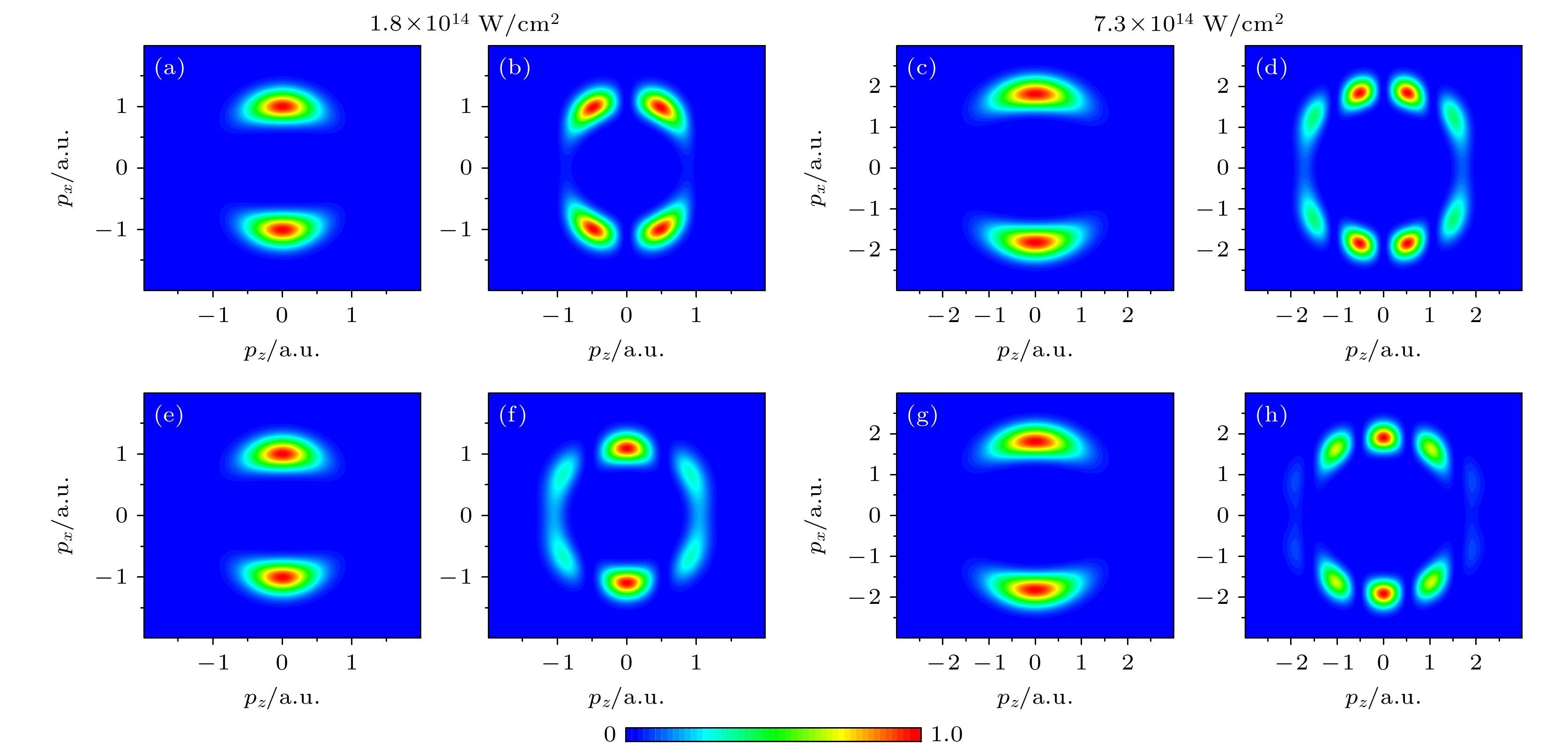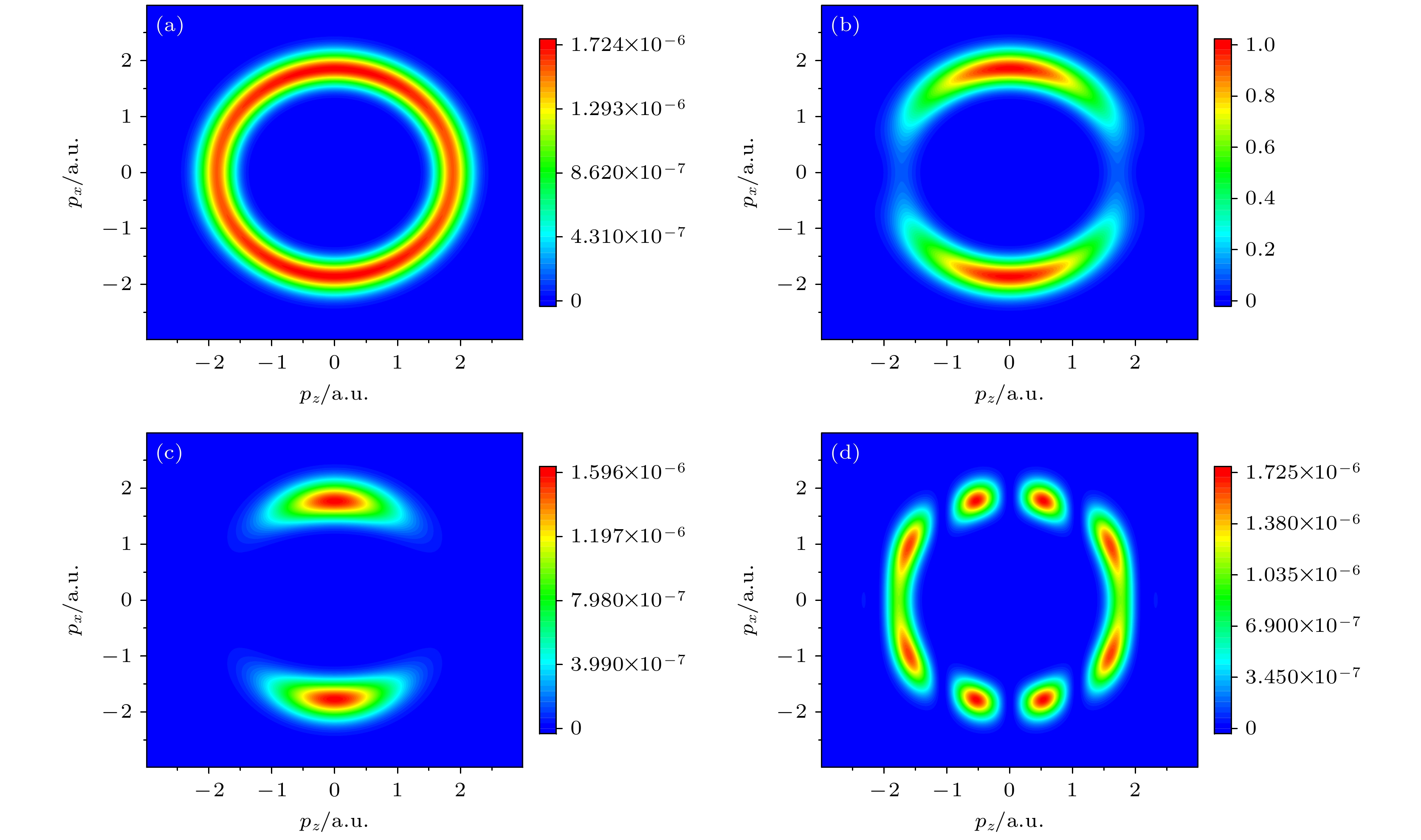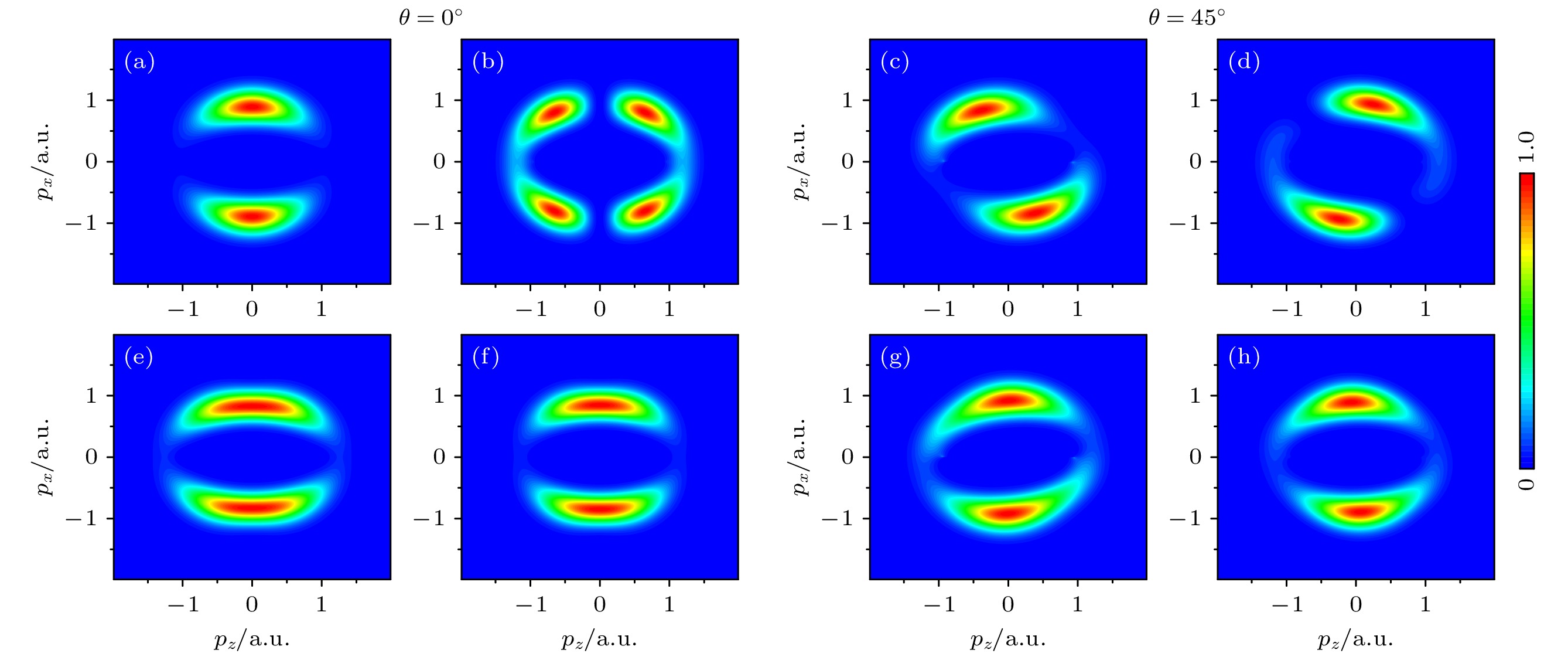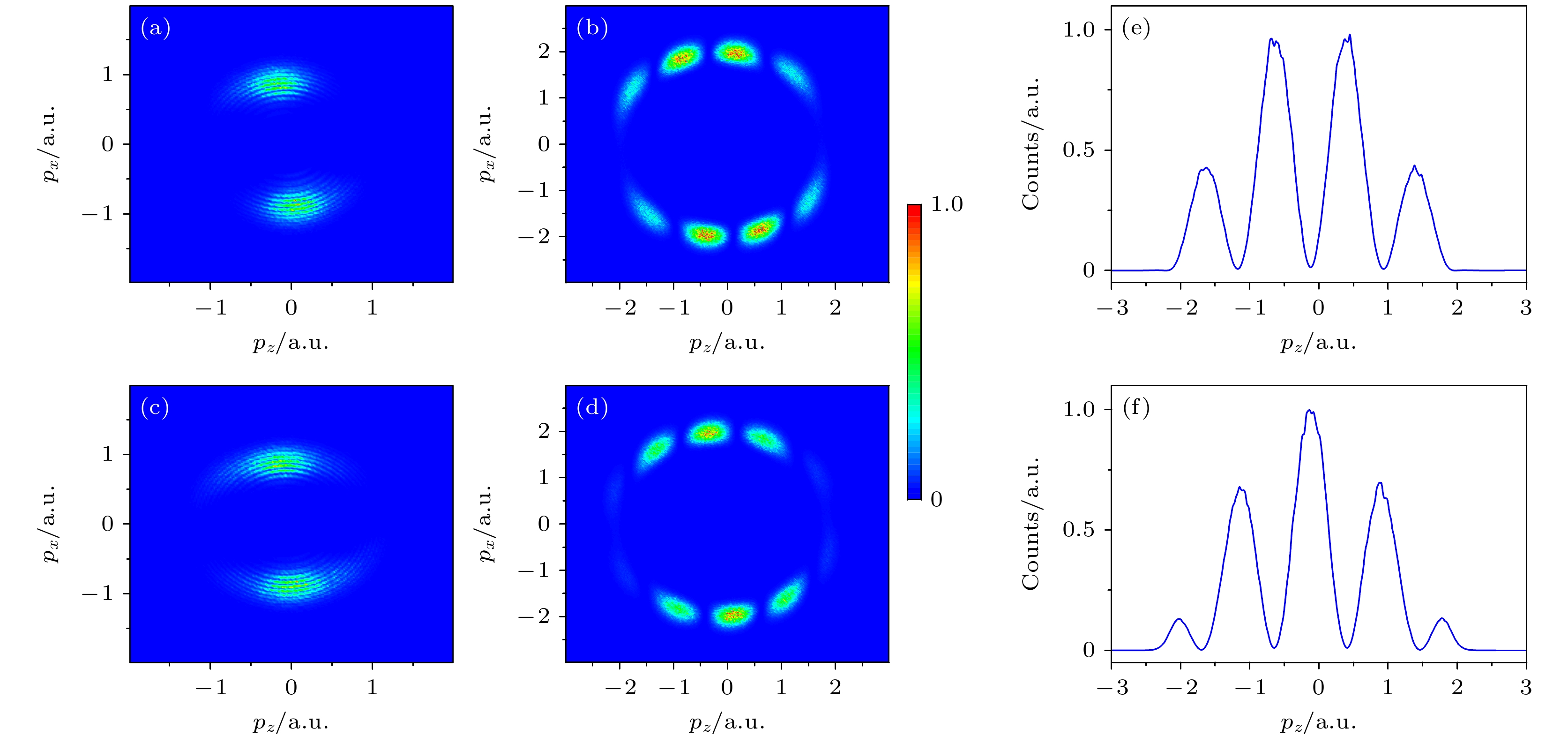-
Despite the molecular strong-field approximation (SFA) theory has made remarkable achievements in describing the ultrafast dynamics of molecules in intense laser fields, there are basic inconsistencies in the theory itself. On the one hand, the basic principle of SFA requires that the initial state be an eigenstate of the system in the absence of the field, and on the other hand, the spatial translation invariance of the physical process requires that the initial state of the system be a laser-field-dressed state. These two conflicting requirements correspond to the two forms of molecular SFA theories, namely, the undressed state and the dressed state. The two theoretical validity and applicability conditions are widely disputed. In this paper, we investigate the ionization processes of N2 and Ne2 molecules in an elliptically polarized laser field and a circularly polarized laser field, aiming to solve the above-mentioned controversies. Elliptically polarized laser can efficiently suppress the re-scattering process and the influence of various interference effects, which makes the ionization process cleaner, and thus can effectively screen the applicable conditions for the dressed and undressed states. We calculate the photoelectron momentum distributions corresponding to different molecular orbitals in the dressed and undressed states by using the SFA and the Coulomb-corrected strong-field approximation and compare them with previous experimental results. For molecules with large nuclear spacing such as Ne2, we find that the dressed state is necessary to accurately characterise their ionization, however, for molecules with small nuclear spacing such as N2, the dressed state description is inapplicable. The conclusions of this work provide a reference for accurately describing laser-induced molecular ultrafast processes and further developing corresponding theories and molecular ultrafast imaging schemes.
-
Keywords:
- elliptically polarized laser field /
- molecule ionization /
- dressing /
- photoelectron momentum distribution
[1] Rost J M, Saalmann U 2019 Nat. Photonics 13 439
 Google Scholar
Google Scholar
[2] Blaga C I, Xu J L, DiChiara A D, Sistrunk E, Zhang K, Agostini P, Miller T A, DiMauro L F, Lin C D 2012 Nature 483 194
 Google Scholar
Google Scholar
[3] Niikura H, Légaré F, Hasbani R, Bandrauk A D, Ivanov M Y, Villeneuve D M, Corkum P B 2002 Nature 417 917
 Google Scholar
Google Scholar
[4] Niikura H, Légaré F, Hasbani R, Ivanov M Y, Villeneuve D M, Corkum P B 2003 Nature 421 826
 Google Scholar
Google Scholar
[5] Uiberacker M, Uphues T, Schultze M, Verhoef A J, Yakovlev V, Kling M F, Rauschenberger J, Kabachnik N M, Schröder H, Lezius M, Kompa K L, Muller H G, Vrakking M J J, Hendel S, Kleineberg U, Heinzmann U, Drescher M, Krausz F 2007 Nature 446 627
 Google Scholar
Google Scholar
[6] Eckle P, Smolarski M, Schlup P, Biegert J, Staudte A, Schöffler M, Muller H G, Dörner R, Keller U 2008 Nat. Phys. 4 565
 Google Scholar
Google Scholar
[7] Faisal F H 1973 J. Phys. B: Atom. Mol. Phys. 6 L89
 Google Scholar
Google Scholar
[8] Reiss H R 1980 Phys. Rev. A 22 1786
 Google Scholar
Google Scholar
[9] Lewenstein M, Balcou P, Ivanov M Y, L’Huillier A, Corkum P B 1994 Phys. Rev. A 49 2117
 Google Scholar
Google Scholar
[10] Muth-Böhm J, Becker A, Faisal F 2000 Phys. Rev. Lett. 85 2280
 Google Scholar
Google Scholar
[11] Kjeldsen T K, Madsen L B 2004 J. Phys. B: At. Mol. Opt. Phys. 37 2033
 Google Scholar
Google Scholar
[12] Milošević D, Paulus G, Bauer D, Becker W 2006 J. Phys. B: At. Mol. Opt. Phys. 39 R203
 Google Scholar
Google Scholar
[13] 刘希望, 张宏丹, 贲帅, 杨士栋, 任鑫, 宋晓红, 杨玮枫 2023 72 198701
 Google Scholar
Google Scholar
Liu X W, Zhang H D, Ben S, Yang S D, Ren X, Song X H, Yang W F 2023 Acta. Phys. Sin. 72 198701
 Google Scholar
Google Scholar
[14] Xu J Y, Guo L, Qi X, Lu R H, Zhang M, Zhang J T, Chen J 2024 Chin. Phys. B 33 093301
 Google Scholar
Google Scholar
[15] Yan T M, Popruzhenko S, Vrakking M, Bauer D 2010 Phys. Rev. Lett. 105 253002
 Google Scholar
Google Scholar
[16] Wang C, Okunishi M, Hao X, Ito Y, Chen J, Yang Y, Lucchese R, Zhang M, Yan B, Li W, Ding D, Ueda K 2016 Phys. Rev. A 93 043422
 Google Scholar
Google Scholar
[17] Yang Y Z, Ren H, Zhang M, Zhou S P, Mu X X, Li X K, Wang Z Z, Deng K, Li M X, Ma P, Li Z, Hao X L, Li W D, Chen J, Wang C C, Ding D J 2023 Nat. Commun. 14 4951
 Google Scholar
Google Scholar
[18] Milošević D 2006 Phys. Rev. A 74 063404
 Google Scholar
Google Scholar
[19] Becker W, Chen J, Chen S G, Milošević D 2007 Phys. Rev. A 76 033403
 Google Scholar
Google Scholar
[20] Pfeiffer A N, Cirelli C, Smolarski M, Dimitrovski D, Abu-Samha M, Madsen L B, Keller U 2012 Nat. Phys. 8 76
 Google Scholar
Google Scholar
[21] Shafir D, Soifer H, Bruner B D, Dagan M, Mairesse Y, Patchkovskii S, Ivanov M Y, Smirnova O, Dudovich N 2012 Nature 485 343
 Google Scholar
Google Scholar
[22] Yu M, Liu K, Li M, Yan J Q, Cao C P, Tan J, Liang J T, Guo K Y, Cao W, Lan P F, Zhang Q B, Zhou Y M, Lu P X 2022 Light: Sci. Appl. 11 215
 Google Scholar
Google Scholar
[23] Wu J, Magrakvelidze M, Schmidt L P H, Kunitski M, Pfeifer T, Schöffler M, Pitzer M, Richter M, Voss S, Sann H, Kim H, Lower J, Jahnke T, Czasch A, Thumm U, Dörner R 2013 Nat. Commun. 4 2177
 Google Scholar
Google Scholar
[24] Serov V V, Bray A W, Kheifets A S 2019 Phys. Rev. A 99 063428
 Google Scholar
Google Scholar
[25] Quan W, Serov V V, Wei M Z, Zhao M, Zhou Y, Wang Y L, Lai X Y, Kheifets A S, Liu X J 2019 Phys. Rev. Lett. 123 223204
 Google Scholar
Google Scholar
[26] Khan A, Trabert D, Eckart S, Kunitski M, Jahnke T, Dörner R 2020 Phys. Rev. A 101 023409
 Google Scholar
Google Scholar
[27] Korneev P A, Popruzhenko S, Goreslavski S, Yan T M, Bauer D, Becker W, Kübel M, Kling M F, Rödel C, Wünsche M, Paulus G G 2012 Phys. Rev. Lett. 108 223601
 Google Scholar
Google Scholar
[28] Pruzhenko S V, Korneev P A, Goreslavski S, Becker W 2002 Phys. Rev. Lett. 89 023001
 Google Scholar
Google Scholar
[29] Hao X L, Chen J, Li W D, Wang B B, Wang X D, Becker W 2014 Phys. Rev. Lett. 112 073002
 Google Scholar
Google Scholar
[30] Maxwell A S, de Morisson Faria C F 2016 Phys. Rev. Lett. 116 143001
 Google Scholar
Google Scholar
[31] Quan W, Hao X L, Wang Y L, Chen Y J, Yu S G, Xu S P, Xiao Z L, Sun R P, Lai X Y, Hu S L, Liu M Q, Shu Z, Wang X D, Li W D, Becker W, Liu X J, Chen J 2017 Phys. Rev. A 96 032511
 Google Scholar
Google Scholar
[32] Kunitski M, Eicke N, Huber P, Köhler J, Zeller S, Voigtsberger J, Schlott N, Henrichs K, Sann H, Trinter F, Schmidt L P H, Kalinin A, Schöffler M S, Jahnke T, Lein M, Dörner R 2019 Nat. Commun. 10 1
 Google Scholar
Google Scholar
[33] Yan J Q, Xie W H, Li M, Liu K, Luo S Q, Cao C P, Guo K Y, Cao W, Lan P F, Zhang Q B, Zhou Y M, Lu P X 2020 Phys. Rev. A 102 013117
 Google Scholar
Google Scholar
[34] Busuladžić M, Gazibegović-Busuladžić A, Miložević D, Becker W 2008 Phys. Rev. A 78 033412
 Google Scholar
Google Scholar
[35] Busuladžić M, Milošević D 2010 Phys. Rev. A 82 015401
 Google Scholar
Google Scholar
[36] Lewenstein M, Kulander K, Schafer K, Bucksbaum P 1995 Phys. Rev. A 51 1495
 Google Scholar
Google Scholar
[37] de Morisson Faria C F, Schomerus H, Becker W 2002 Phys. Rev. A 66 043413
 Google Scholar
Google Scholar
[38] Usachenko V I, Chu S I 2005 Phys. Rev. A 71 063410
 Google Scholar
Google Scholar
[39] Guo Z N, Liu Y Q 2020 J. Phys. B: At. Mol. Opt. Phys. 53 065004
 Google Scholar
Google Scholar
-
图 1 Ne2的(a) $2{\mathrm{p}} {\text{σ}}_{\mathrm{g}} $和(b) $ 2{\mathrm{p}}{\text{σ}}_{\mathrm{u }}$轨道坐标空间波函数的二维分布. 图(a)中的点A和点B分别表示两个原子中心的位置, 它们之间的距离标记为$ R_{0} $. 电子与原子中心A的相对位置矢量为$ {\boldsymbol{r}}_{{{A}}} $, 与原子中心B的相对位置矢量为$ {\boldsymbol{r}}_{{{B}}} $
Figure 1. Two-dimensional distributions spatial wave functions of the (a) $2{\mathrm{p }}{\text{σ}}_{\mathrm{g}} $ and (b) $ 2{\mathrm{p}}{\text{σ}}_{\mathrm{u}} $ orbitals for Ne2 respectively. Panel (a) shows the positions of the two atomic centres, A and B, with the distance between them marked as $ R_0 $. The electronic relative position vector to atomic centre A is denoted by $ {\boldsymbol{r}}_{A} $, and the relative position vector to atomic centre B is denoted by $ {\boldsymbol{r}}_{B} $
图 2 用SFA方法计算的Ne2在圆偏振光下的对称轨道$ 2{\mathrm{p}}{\text{σ}}_{\mathrm{g}} $ (第一行)和反对称轨道$ 2{\mathrm{p}}{\text{σ}}_{\mathrm{u}} $ (第二行)的PMD, 其中包括了非缀饰态(a), (c), (e), (g)和缀饰态(b), (d), (f), (h). 计算中分子轴沿着z轴方向排列, Ne—Ne键长为5.86 a.u., 左侧一组图(a), (b), (e), (f)和右侧一组图(c), (d), (g), (h)的激光峰值光强分别为$ 1.8\times10^{14}\; {\mathrm{W/cm}}^{2} $和$ 7.3\times10^{14}\; {\mathrm{W/cm}}^{2} $, 波长均为780 nm
Figure 2. Photoelectron momentum distributions (PMD) calculated by the SFA method for the symmetric orbitals $ 2{\mathrm{p}}{\text{σ}}_{\mathrm{g}} $ (the first row) and antisymmetric orbitals $ 2{\mathrm{p}}{\text{σ}}_{\mathrm{u}} $ (the second row) in circularly polarized light for Ne2, which includes both the dressing state (a), (c), (e), (g) and the undressing state (b), (d), (f), (h). The molecular axes are aligned along the z-axis, the Ne—Ne bond length is 5.86 a.u. The left set of panels has the peak laser intensity is $ 1.8\times10^{14}\; {\mathrm{W/cm}}^{2} $, while the right set of panels is $ 7.3\times10^{14}\; {\mathrm{W/cm}}^{2} $, the wavelength of both is 780 nm.
图 3 SFA方法中考虑不同项计算得到的Ne2在圆偏振光下对称性轨道$ 2{\mathrm{p}}{\text{σ}}_{\rm{g}} $的光电子动量分布. (a) (5)式中不考虑$ V_{p_0} $时的PMD; (b)$ V_{p_0} $中不考虑分子干涉项时的PMD; (c)$ V_{p_0} $中只考虑非缀饰态干涉项时的PMD; (d)$ V_{p_0} $中只考虑缀饰态干涉项时的PMD. 激光峰值光强为$ 7.3\times10^{14} \;{\mathrm{W/cm}}^{2} $, 波长为780 nm. 具体细节请参考文中表述
Figure 3. The PMD of the symmetry orbital $2{\mathrm{p}}{\text{σ}}_{\rm{g}} $ of Ne2 in circularly polarized light calculated by considering different terms in the SFA method: (a) The PMD obtained when $ V_{p_0} $ is not considered in Eq. (5); (b) the PMD obtained when $ V_{p_0} $ is included but the molecular interference term is removed; (c) the PMD with only the undressed state interference term considered in $ V_{p_0} $; (d) the PMD with only the dressed state interference term considered in $ V_{p_0} $. The peak laser intensity is $ 7.3\times10^{14}\; {\mathrm{W/cm}}^{2} $, the wavelength is 780 nm. For details, please refer to the text.
图 4 缀饰态下的Ne2对称$ 2{\mathrm{p}}{\text{σ}}_{\rm{g}} $ (a)和反对称$ 2{\mathrm{p}}{\text{σ}}_{\rm{u}}$(b)轨道的电离率随$ p_{z} $的分布, 即将图2(d)和图2(h)中分布的$ p_{x} $方向动量积分
Figure 4. Distribution of the ionization rates with $ p_{z} $ for the symmetric $ 2{\mathrm{p}}{\text{σ}}_{\rm{g}} $ (a) and antisymmetric $ 2{\mathrm{p}}{\text{σ}}_{\rm{u}} $ (b) orbitals of Ne2 in the dressed state, i.e., integrating the x-direction momentum distributions in Fig. 2(d) and Fig. 2(h).
图 5 SFA方法计算的N2在椭圆偏振光下HOMO (a), (b), (c), (d) 和HOMO-1 (e), (f), (g), (h) 的光电子动量分布, 其中(a), (c), (e), (g)是非缀饰态的情况, (b), (d), (f), (h)是缀饰态的情况. 左侧一组图和右侧一组图的准直角分别为$ 0^\circ $和$ 45^\circ $. 分子轴沿着z轴方向排列, 准直角被定义为分子轴与激光场长轴方向之间的夹角. N—N键长为2.073 a.u., 激光场峰值光强是$ 1.8\times $$ 10^{14}\;{\mathrm{ W/cm}}^{2} $, 波长是800 nm, 椭偏率是0.82
Figure 5. The PMD of N2 in elliptical laser fields for HOMO (a), (b), (c), (d) and HOMO-1 (e), (f), (g), (h) calculated by the SFA method, which (a), (c), (e), (g) are the case of the undressed state, and (b), (d), (f), (h) are the cases of the dressed state. The left set of panels and the right set of panels are aligned at angles $ 0^\circ $ and $ 45^\circ $, respectively. The molecular axes are aligned along the z-axis direction, the alignment angle is defined as the angle between the molecular axis and the main axis of the laser field. The N—N bond length is 2.073 a.u., the peak laser intensity is $ 1.8 \times10^{14}\;{\mathrm{ W/cm}}^{2} $, the wavelength is 800 nm, and the ellipticity is 0.82.
图 6 库仑修正强场近似(CCSFA)方法计算的N2和Ne2在(椭)圆偏振光下不同轨道的光电子动量分布. (a), (c)是 N2在非缀饰态下的HOMO和HOMO-1的动量分布, 激光峰值光强为$ 1.8\times10^{14}\;{\rm{W}}/{\rm{cm}}^{2} $, 波长为800 nm, 椭偏率为0.82; (b), (d)是 Ne2在缀饰态下的对称性$ {\text{σ}}_{\mathrm{g }} $轨道和反对称性$ {\text{σ}}_{\mathrm{u }}$轨道的动量分布, 激光峰值光强为$ 7.3\times10^{14}\;{\rm{W}}/{\rm{cm}}^{2} $, 波长为780 nm, 椭偏率为1; (e), (f)分别展示了将(b) 和(d)中的分布旋转一定角度并将$ p_{x} $方向动量积分后的结果
Figure 6. Photoelectron momentum distributions of different orbitals in (elliptical) circular polarized light for N2 and Ne2 calculated by the CCSFA. The momentum distributions of HOMO (a) and HOMO-1 (c) for N2 in the undressing state, the peak laser intensity is $ 1.8 \times10^{14}\; {\rm{W}}/{\rm{cm}}^{2} $, the wavelength is 800 nm, and the ellipticity is 0.82; the momentum distributions of symmetric $ {\text{σ}}_{\mathrm{g}}$ orbital (b) and antisymmetric $ {\text{σ}}_{\rm{u}} $ orbital (d) for Ne2 in the dressing state, respectively, the peak laser intensity is $ 7.3 \times10^{14}\; {\rm{W}}/{\rm{cm}}^{2} $, the wavelength is 780 nm, and the ellipticity is 1; (e), (f) the results after rotating the distributions in panels (b) and (d) by a given angle and integrating the momentum in the $ p_{x} $ direction, respectively.
-
[1] Rost J M, Saalmann U 2019 Nat. Photonics 13 439
 Google Scholar
Google Scholar
[2] Blaga C I, Xu J L, DiChiara A D, Sistrunk E, Zhang K, Agostini P, Miller T A, DiMauro L F, Lin C D 2012 Nature 483 194
 Google Scholar
Google Scholar
[3] Niikura H, Légaré F, Hasbani R, Bandrauk A D, Ivanov M Y, Villeneuve D M, Corkum P B 2002 Nature 417 917
 Google Scholar
Google Scholar
[4] Niikura H, Légaré F, Hasbani R, Ivanov M Y, Villeneuve D M, Corkum P B 2003 Nature 421 826
 Google Scholar
Google Scholar
[5] Uiberacker M, Uphues T, Schultze M, Verhoef A J, Yakovlev V, Kling M F, Rauschenberger J, Kabachnik N M, Schröder H, Lezius M, Kompa K L, Muller H G, Vrakking M J J, Hendel S, Kleineberg U, Heinzmann U, Drescher M, Krausz F 2007 Nature 446 627
 Google Scholar
Google Scholar
[6] Eckle P, Smolarski M, Schlup P, Biegert J, Staudte A, Schöffler M, Muller H G, Dörner R, Keller U 2008 Nat. Phys. 4 565
 Google Scholar
Google Scholar
[7] Faisal F H 1973 J. Phys. B: Atom. Mol. Phys. 6 L89
 Google Scholar
Google Scholar
[8] Reiss H R 1980 Phys. Rev. A 22 1786
 Google Scholar
Google Scholar
[9] Lewenstein M, Balcou P, Ivanov M Y, L’Huillier A, Corkum P B 1994 Phys. Rev. A 49 2117
 Google Scholar
Google Scholar
[10] Muth-Böhm J, Becker A, Faisal F 2000 Phys. Rev. Lett. 85 2280
 Google Scholar
Google Scholar
[11] Kjeldsen T K, Madsen L B 2004 J. Phys. B: At. Mol. Opt. Phys. 37 2033
 Google Scholar
Google Scholar
[12] Milošević D, Paulus G, Bauer D, Becker W 2006 J. Phys. B: At. Mol. Opt. Phys. 39 R203
 Google Scholar
Google Scholar
[13] 刘希望, 张宏丹, 贲帅, 杨士栋, 任鑫, 宋晓红, 杨玮枫 2023 72 198701
 Google Scholar
Google Scholar
Liu X W, Zhang H D, Ben S, Yang S D, Ren X, Song X H, Yang W F 2023 Acta. Phys. Sin. 72 198701
 Google Scholar
Google Scholar
[14] Xu J Y, Guo L, Qi X, Lu R H, Zhang M, Zhang J T, Chen J 2024 Chin. Phys. B 33 093301
 Google Scholar
Google Scholar
[15] Yan T M, Popruzhenko S, Vrakking M, Bauer D 2010 Phys. Rev. Lett. 105 253002
 Google Scholar
Google Scholar
[16] Wang C, Okunishi M, Hao X, Ito Y, Chen J, Yang Y, Lucchese R, Zhang M, Yan B, Li W, Ding D, Ueda K 2016 Phys. Rev. A 93 043422
 Google Scholar
Google Scholar
[17] Yang Y Z, Ren H, Zhang M, Zhou S P, Mu X X, Li X K, Wang Z Z, Deng K, Li M X, Ma P, Li Z, Hao X L, Li W D, Chen J, Wang C C, Ding D J 2023 Nat. Commun. 14 4951
 Google Scholar
Google Scholar
[18] Milošević D 2006 Phys. Rev. A 74 063404
 Google Scholar
Google Scholar
[19] Becker W, Chen J, Chen S G, Milošević D 2007 Phys. Rev. A 76 033403
 Google Scholar
Google Scholar
[20] Pfeiffer A N, Cirelli C, Smolarski M, Dimitrovski D, Abu-Samha M, Madsen L B, Keller U 2012 Nat. Phys. 8 76
 Google Scholar
Google Scholar
[21] Shafir D, Soifer H, Bruner B D, Dagan M, Mairesse Y, Patchkovskii S, Ivanov M Y, Smirnova O, Dudovich N 2012 Nature 485 343
 Google Scholar
Google Scholar
[22] Yu M, Liu K, Li M, Yan J Q, Cao C P, Tan J, Liang J T, Guo K Y, Cao W, Lan P F, Zhang Q B, Zhou Y M, Lu P X 2022 Light: Sci. Appl. 11 215
 Google Scholar
Google Scholar
[23] Wu J, Magrakvelidze M, Schmidt L P H, Kunitski M, Pfeifer T, Schöffler M, Pitzer M, Richter M, Voss S, Sann H, Kim H, Lower J, Jahnke T, Czasch A, Thumm U, Dörner R 2013 Nat. Commun. 4 2177
 Google Scholar
Google Scholar
[24] Serov V V, Bray A W, Kheifets A S 2019 Phys. Rev. A 99 063428
 Google Scholar
Google Scholar
[25] Quan W, Serov V V, Wei M Z, Zhao M, Zhou Y, Wang Y L, Lai X Y, Kheifets A S, Liu X J 2019 Phys. Rev. Lett. 123 223204
 Google Scholar
Google Scholar
[26] Khan A, Trabert D, Eckart S, Kunitski M, Jahnke T, Dörner R 2020 Phys. Rev. A 101 023409
 Google Scholar
Google Scholar
[27] Korneev P A, Popruzhenko S, Goreslavski S, Yan T M, Bauer D, Becker W, Kübel M, Kling M F, Rödel C, Wünsche M, Paulus G G 2012 Phys. Rev. Lett. 108 223601
 Google Scholar
Google Scholar
[28] Pruzhenko S V, Korneev P A, Goreslavski S, Becker W 2002 Phys. Rev. Lett. 89 023001
 Google Scholar
Google Scholar
[29] Hao X L, Chen J, Li W D, Wang B B, Wang X D, Becker W 2014 Phys. Rev. Lett. 112 073002
 Google Scholar
Google Scholar
[30] Maxwell A S, de Morisson Faria C F 2016 Phys. Rev. Lett. 116 143001
 Google Scholar
Google Scholar
[31] Quan W, Hao X L, Wang Y L, Chen Y J, Yu S G, Xu S P, Xiao Z L, Sun R P, Lai X Y, Hu S L, Liu M Q, Shu Z, Wang X D, Li W D, Becker W, Liu X J, Chen J 2017 Phys. Rev. A 96 032511
 Google Scholar
Google Scholar
[32] Kunitski M, Eicke N, Huber P, Köhler J, Zeller S, Voigtsberger J, Schlott N, Henrichs K, Sann H, Trinter F, Schmidt L P H, Kalinin A, Schöffler M S, Jahnke T, Lein M, Dörner R 2019 Nat. Commun. 10 1
 Google Scholar
Google Scholar
[33] Yan J Q, Xie W H, Li M, Liu K, Luo S Q, Cao C P, Guo K Y, Cao W, Lan P F, Zhang Q B, Zhou Y M, Lu P X 2020 Phys. Rev. A 102 013117
 Google Scholar
Google Scholar
[34] Busuladžić M, Gazibegović-Busuladžić A, Miložević D, Becker W 2008 Phys. Rev. A 78 033412
 Google Scholar
Google Scholar
[35] Busuladžić M, Milošević D 2010 Phys. Rev. A 82 015401
 Google Scholar
Google Scholar
[36] Lewenstein M, Kulander K, Schafer K, Bucksbaum P 1995 Phys. Rev. A 51 1495
 Google Scholar
Google Scholar
[37] de Morisson Faria C F, Schomerus H, Becker W 2002 Phys. Rev. A 66 043413
 Google Scholar
Google Scholar
[38] Usachenko V I, Chu S I 2005 Phys. Rev. A 71 063410
 Google Scholar
Google Scholar
[39] Guo Z N, Liu Y Q 2020 J. Phys. B: At. Mol. Opt. Phys. 53 065004
 Google Scholar
Google Scholar
Catalog
Metrics
- Abstract views: 991
- PDF Downloads: 81
- Cited By: 0















 DownLoad:
DownLoad:





